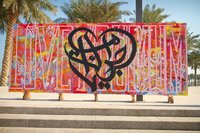 Love You Mum
Love You Mum In 2010, The Museum of Islamic Art invited eL Seed to do a weeklong residence during which he would create multiple pieces of Calligraffiti art for the museum as well as conducting graffiti workshops for local high school students. The workshops taught the various techniques used by graffiti artists and allowed the students to contribute the pieces eL Seed was creating for the Museum (eL Seed Art)
The invitation extended by The Museum of Islamic Art towards eL Seed was an acknowledgment of Calligraffiti as an Islamic art form by the Museum. Graffiti has often been recognized as lesser genre of art, in the past couple decades as artists have taken their artistic talent off the street and into art galleries, the art form has gained much recognition. This acceptance by a conservative museum like the Museum of Islamic Art was another large step forward for Calligraffiti as well as Graffiti in general. eL Seed described his feelings about the experience, saying, “I felt that the Museum was striving to both carry the traditions of Islamic Art and keep a vision oriented toward the future,” (eL Seed Art).
Love you Mum was one of the several paintings created by eL Seed during the short residency. On a pink background eL Seed taped out the English phrase “Love you Mum,” and asked students to practice the graffiti techniques he had taught them on the piece. Once the students had completed their work, eL Seed removed the tape, revealing the phrase in pink letters. This composition was used as the background to the focus of the painting. In the middle, in solid black, in a heart shape, is Arabic Calligraffiti, which translates to “I love you Mom.” The use of multiple languages, as well as students from different faiths and backgrounds in this painting is another example of Calligraffiti’s ability to fuse different cultures and religions into a stunning work of art.
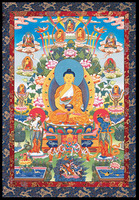 Tibetan Humanity Healing
Tibetan Humanity Healing Tulkism is rarely well known outside of the esoteric Buddhism traditions. It is an intimate term mainly used by the Tibetan Lamas. It is expressed by the belief of a lineage of beings that are directly connected to a central being. The lineage of the Dalai Lama is an example of this. The Dalai Lama is the representative of the Avalokiteshvara, the Bodhisattva of Compassion, which is why it is so important to find the new one when the old one has passed.
The word tulku literally means “a form created by magic process”. It is almost always from Agarthinian in origin, which means they are beings from the Sudha Dharma Mandalam, or the Great White Fraternity, or mysterious beings that, from time to time, emerge onto the surface of the Earth in order to transform it. Among the Tibetans and Mongols, these are known as “Shambahla people”.
In addition to choosing the manner of their rebirth, tulkus are able, on their deathbed, to make known the place of their next birth, sometimes adding various details about their future parents, the situation of their house and so on. If such details are lacking, the monks whose duty it is to locate his reincarnation, resort to a lama-tulku astrologer, or tsispa, for directions.
In the image, the lines of the seven main Bodhisattvas came from the Buddhic, or Christic beings. In their turn, the Seven Manus sprang from the seven main Bodhisattvas. From the Manus, new centers are generated and from them emanate the tulkus with infinite emanations and manifestations of consciousness.
The living Buddha is a tulku, or a mayavic shadow projected by a Buddha. The Dalai Lama is an incarnated disciple, hence the origin of the words: Lha and Ma, where the spirit takes upon incarnation or the word is made flesh.
 Pony Mary Statue of the Virgin Mary as a My Little Pony Centaur
Pony Mary Statue of the Virgin Mary as a My Little Pony Centaur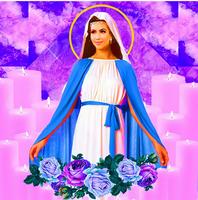 Kim Kardashian as The Virgin Mary
Kim Kardashian as The Virgin Mary 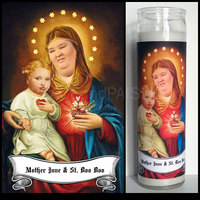 Candle of Madonna and Child Candle of Mama June and Honey Boo boo as Madonna and Child
Candle of Madonna and Child Candle of Mama June and Honey Boo boo as Madonna and Child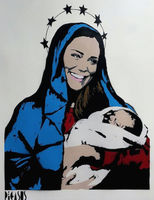 Madonna and Child
Madonna and Child 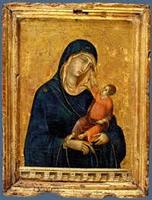 Madonna and Child
Madonna and Child 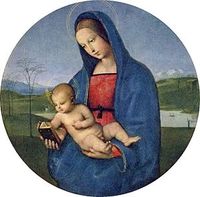 Conestabile Madonna
Conestabile Madonna 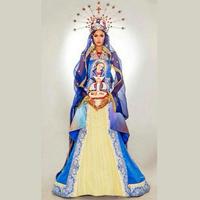 The Virgin of the Highest Grace Dress Miss Universe 2014 contestant for the Dominican Republic- Kimberly Castillo wearing the dress
The Virgin of the Highest Grace Dress Miss Universe 2014 contestant for the Dominican Republic- Kimberly Castillo wearing the dress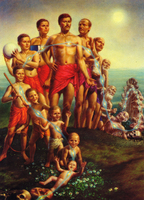 Birth. Death. Rebirth.
Birth. Death. Rebirth. 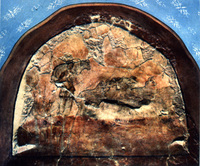 The Good Shepherd
The Good Shepherd 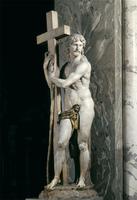 Risen Christ
Risen Christ 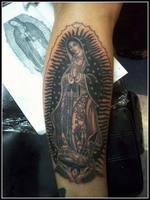 Our Lady of Guadalupe Tattoo Our Lady of Guadalupe Tattoo on a forearm
Our Lady of Guadalupe Tattoo Our Lady of Guadalupe Tattoo on a forearm Love You Mum In 2010, The Museum of Islamic Art invited eL Seed to do a weeklong residence during which he would create multiple pieces of Calligraffiti art for the museum as well as conducting graffiti workshops for local high school students. The workshops taught the various techniques used by graffiti artists and allowed the students to contribute the pieces eL Seed was creating for the Museum (eL Seed Art) The invitation extended by The Museum of Islamic Art towards eL Seed was an acknowledgment of Calligraffiti as an Islamic art form by the Museum. Graffiti has often been recognized as lesser genre of art, in the past couple decades as artists have taken their artistic talent off the street and into art galleries, the art form has gained much recognition. This acceptance by a conservative museum like the Museum of Islamic Art was another large step forward for Calligraffiti as well as Graffiti in general. eL Seed described his feelings about the experience, saying, “I felt that the Museum was striving to both carry the traditions of Islamic Art and keep a vision oriented toward the future,” (eL Seed Art). Love you Mum was one of the several paintings created by eL Seed during the short residency. On a pink background eL Seed taped out the English phrase “Love you Mum,” and asked students to practice the graffiti techniques he had taught them on the piece. Once the students had completed their work, eL Seed removed the tape, revealing the phrase in pink letters. This composition was used as the background to the focus of the painting. In the middle, in solid black, in a heart shape, is Arabic Calligraffiti, which translates to “I love you Mom.” The use of multiple languages, as well as students from different faiths and backgrounds in this painting is another example of Calligraffiti’s ability to fuse different cultures and religions into a stunning work of art.
Love You Mum In 2010, The Museum of Islamic Art invited eL Seed to do a weeklong residence during which he would create multiple pieces of Calligraffiti art for the museum as well as conducting graffiti workshops for local high school students. The workshops taught the various techniques used by graffiti artists and allowed the students to contribute the pieces eL Seed was creating for the Museum (eL Seed Art) The invitation extended by The Museum of Islamic Art towards eL Seed was an acknowledgment of Calligraffiti as an Islamic art form by the Museum. Graffiti has often been recognized as lesser genre of art, in the past couple decades as artists have taken their artistic talent off the street and into art galleries, the art form has gained much recognition. This acceptance by a conservative museum like the Museum of Islamic Art was another large step forward for Calligraffiti as well as Graffiti in general. eL Seed described his feelings about the experience, saying, “I felt that the Museum was striving to both carry the traditions of Islamic Art and keep a vision oriented toward the future,” (eL Seed Art). Love you Mum was one of the several paintings created by eL Seed during the short residency. On a pink background eL Seed taped out the English phrase “Love you Mum,” and asked students to practice the graffiti techniques he had taught them on the piece. Once the students had completed their work, eL Seed removed the tape, revealing the phrase in pink letters. This composition was used as the background to the focus of the painting. In the middle, in solid black, in a heart shape, is Arabic Calligraffiti, which translates to “I love you Mom.” The use of multiple languages, as well as students from different faiths and backgrounds in this painting is another example of Calligraffiti’s ability to fuse different cultures and religions into a stunning work of art.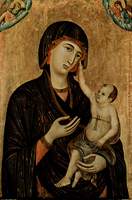 Duccio di Buoninsegna Madonna and Child
Duccio di Buoninsegna Madonna and Child 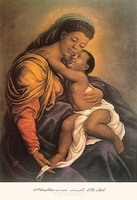 African American Madonna and Child
African American Madonna and Child  Two Traills, snowy & clear
Two Traills, snowy & clear 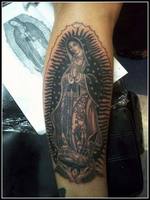 Tattoo of The Virgin of Guadalupe
Tattoo of The Virgin of Guadalupe 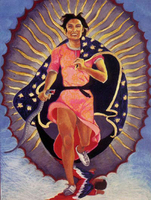 Portrait of the Artist as the Virgin of Guadalupe,1978
Portrait of the Artist as the Virgin of Guadalupe,1978 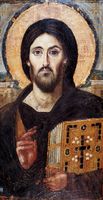 Christ Pantocrator
Christ Pantocrator  Christ Pantocrator
Christ Pantocrator  The Virgin of Guadalupe
The Virgin of Guadalupe  The Fourth Day of the Sun Dance
The Fourth Day of the Sun Dance 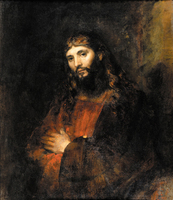 Christ with Arms Folded
Christ with Arms Folded  Tibetan Humanity Healing Tulkism is rarely well known outside of the esoteric Buddhism traditions. It is an intimate term mainly used by the Tibetan Lamas. It is expressed by the belief of a lineage of beings that are directly connected to a central being. The lineage of the Dalai Lama is an example of this. The Dalai Lama is the representative of the Avalokiteshvara, the Bodhisattva of Compassion, which is why it is so important to find the new one when the old one has passed. The word tulku literally means “a form created by magic process”. It is almost always from Agarthinian in origin, which means they are beings from the Sudha Dharma Mandalam, or the Great White Fraternity, or mysterious beings that, from time to time, emerge onto the surface of the Earth in order to transform it. Among the Tibetans and Mongols, these are known as “Shambahla people”. In addition to choosing the manner of their rebirth, tulkus are able, on their deathbed, to make known the place of their next birth, sometimes adding various details about their future parents, the situation of their house and so on. If such details are lacking, the monks whose duty it is to locate his reincarnation, resort to a lama-tulku astrologer, or tsispa, for directions. In the image, the lines of the seven main Bodhisattvas came from the Buddhic, or Christic beings. In their turn, the Seven Manus sprang from the seven main Bodhisattvas. From the Manus, new centers are generated and from them emanate the tulkus with infinite emanations and manifestations of consciousness. The living Buddha is a tulku, or a mayavic shadow projected by a Buddha. The Dalai Lama is an incarnated disciple, hence the origin of the words: Lha and Ma, where the spirit takes upon incarnation or the word is made flesh.
Tibetan Humanity Healing Tulkism is rarely well known outside of the esoteric Buddhism traditions. It is an intimate term mainly used by the Tibetan Lamas. It is expressed by the belief of a lineage of beings that are directly connected to a central being. The lineage of the Dalai Lama is an example of this. The Dalai Lama is the representative of the Avalokiteshvara, the Bodhisattva of Compassion, which is why it is so important to find the new one when the old one has passed. The word tulku literally means “a form created by magic process”. It is almost always from Agarthinian in origin, which means they are beings from the Sudha Dharma Mandalam, or the Great White Fraternity, or mysterious beings that, from time to time, emerge onto the surface of the Earth in order to transform it. Among the Tibetans and Mongols, these are known as “Shambahla people”. In addition to choosing the manner of their rebirth, tulkus are able, on their deathbed, to make known the place of their next birth, sometimes adding various details about their future parents, the situation of their house and so on. If such details are lacking, the monks whose duty it is to locate his reincarnation, resort to a lama-tulku astrologer, or tsispa, for directions. In the image, the lines of the seven main Bodhisattvas came from the Buddhic, or Christic beings. In their turn, the Seven Manus sprang from the seven main Bodhisattvas. From the Manus, new centers are generated and from them emanate the tulkus with infinite emanations and manifestations of consciousness. The living Buddha is a tulku, or a mayavic shadow projected by a Buddha. The Dalai Lama is an incarnated disciple, hence the origin of the words: Lha and Ma, where the spirit takes upon incarnation or the word is made flesh.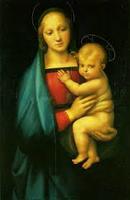 Madonna del Granduca
Madonna del Granduca 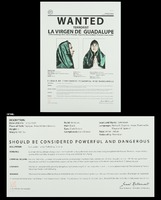 Wanted Created in protest of the Arizona Immigration Bill 1070 due to the anti-immigrant/racial profiling situation in Arizona.
Wanted Created in protest of the Arizona Immigration Bill 1070 due to the anti-immigrant/racial profiling situation in Arizona.